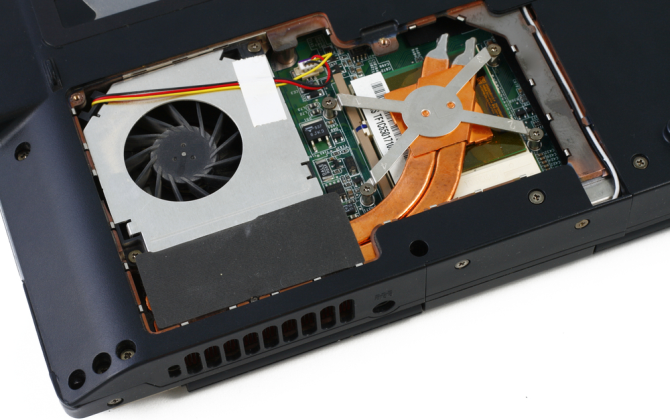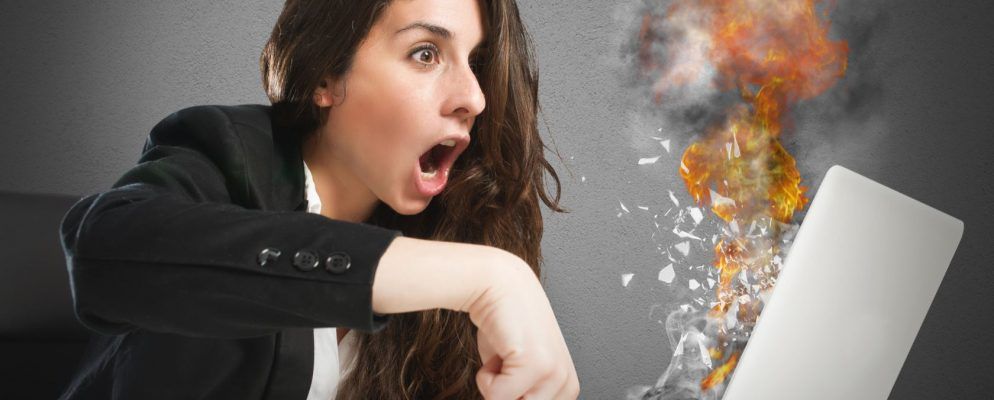Laptops have become more powerful and compact than ever before. A steep increase in CPU performance is facilitated by chips that are ever more densely packed with transistors.
In parallel, slimmer cases pack an increasing number of processors and stronger graphics cards support bigger screens with higher resolutions. These developments come at a cost: excess heat.
The greatest threat for your laptop, except for your coffee, is overheating. It can cause hardware failure and permanent damage. Let me show you how to prevent or fix an overheating laptop and thus improve the performance and extend the lifespan of your computer.
The Basics of Overheating Computers
How Do You Know Your Laptop Is Overheating?
Just because your laptop seems hot
PC Operating Temperatures: How Hot Is Too Hot?
PC Operating Temperatures: How Hot Is Too Hot?
Excessive heat can damage your computer’s performance and lifespan. But at what point is it overheating? How hot is too hot?
Read More
doesn’t mean it’s overheating.
A sure sign that your computer is overheating is when your fan is always running at maximum speed. You may also experience reduced performance because an overheating CPU cuts back its clock speed to escape heat pressure. Moreover, the fail-safe software may trigger a sudden shut down to prevent hardware damage.

If you want to measure the actual heat values inside your laptop, you can use a tool like HWMonitor. This might also reveal which part of your laptop is getting too hot. Typically, you’ll find that the CPU or GPU are overheating the most.
What Causes Overheating?
In two words: insufficient cooling.
Potential reasons include dust blocking intake grills or exhaust ports, a clogged up fan, or a degenerated thermal grease (aka thermal compound) between the heat sink and the CPU or GPU. You can fix all of these things yourself, though some jobs will be tougher than others.
If you need a quick fix and don’t have the handy skills to de-lid your CPU and apply fresh thermal paste, read on.
How Can You Prevent or Fix an Overheating Laptop?
Several simple hardware fixes can cure overheating.
1. Fix Internal Cooling
The first and most important thing you need to do when your laptop is overheating is to clean the fan(s) that provide(s) cooling to the CPU and graphics card. Over time, they build up layers of dust and dirt that slow them down and block airflow. Consult your laptop’s manual or manufacturer to find out how you can open the laptop to access and clean these parts.
Before you attempt to do any cleaning, however, follow these steps:
- Shut down the computer
- Remove the battery
- Unplug the power strip
- Ground yourself
Carefully clean the fan(s) with a cotton swab dipped in a drop of alcohol. Make sure the alcohol has completely evaporated before you reconnect the laptop to the power.
You can also use a vacuum cleaner to remove the dust and dirt that clocks up the fan(s). To prevent damage to the fan, do not let it revolve in the wrong direction. If you want to use canned air to clean the fan, stop the fan from spinning by holding it down.

Next, you can clean the exhaust port by sucking out air with a vacuum cleaner. The exhaust port usually sits on the side of the laptop. It’s the opening that blows out hot air.
The intake grills are small openings that allow air to be sucked into the laptop by the revolving fans. They can sit on the sides or at the bottom of your notebook. To clear the intake grills, spray them with canned air.
Finally, you can apply fresh thermal grease to the interface between the CPU and its heat sink. Again, please consult the laptop’s manual or manufacturer to obtain instructions on how to disassemble these components.
See our guide on cleaning out dust from your MacBook or iMac
How to Clean Out Dust From Your MacBook or iMac
How to Clean Out Dust From Your MacBook or iMac
Cleaning dust out of a Mac isn’t as easy as cleaning dust out of a PC, but it’s not impossible. Here’s what you need to know.
Read More
if that’s the hardware you use. Furthermore, Inside My Laptop has some great tutorials on how to fix your laptop, including how to apply thermal grease to your laptop’s processor.
2. Keep the Laptop on a Hard and Flat Surface
Most laptops suck in cooling air through their bottoms. Uneven surfaces, like a blanket, pillow, or your lap, obstruct your laptop’s airflow. Subsequently, cooling is impaired, heat builds up, your laptop surfaces get hot, the temperature of sucked in cooling air increases, and eventually the laptop is overheating.
This scenario is easily avoided by keeping the laptop on a hard and flat surface. You can use something as simple as a tray or get a special laptop holder or lap stand. We’ve previously recommended laptop trays.
Personally, I’m using a bamboo laptop desk like the one below for surfing on the sofa:
Ej. Life Bamboo Laptop Bed Desk Tray Folding Bed Desk Table Breakfast Serving Bed Tray with Drawer
Ej. Life Bamboo Laptop Bed Desk Tray Folding Bed Desk Table Breakfast Serving Bed Tray with Drawer
Buy Now On Amazon $26.00
3. Invest in a Laptop Cooler or Cooling Pad
Laptop coolers are meant to provide additional cooling. However, getting the wrong cooler can actually make the problem worse. Before you purchase a cooler, you need to understand the flow of air into and out of your laptop.

As mentioned above, most laptops suck in air for cooling from the bottom. This makes sense because warm air rises upwards. However, a cooler that sits underneath the laptop and sucks air away from it, does not contribute to laptop cooling and rather accelerates overheating.
If your laptop has intake grills at its bottom, purchase a cooler that blows cool air upwards, i.e. into the laptop. You can also get a passive cooler that does not consume power and merely absorbs heat.
Cooler Master NotePal X-Slim Ultra-Slim Laptop Cooling Pad with 160mm Fan (R9-NBC-XSLI-GP)
Cooler Master NotePal X-Slim Ultra-Slim Laptop Cooling Pad with 160mm Fan (R9-NBC-XSLI-GP)
Buy Now On Amazon $15.99
If you’re handy, you can build your own laptop cooler or cooling pad. We even found a solution that will cost you under five bucks!
What Are Potential Software Fixes?
If none of the hardware fixes result in lasting improvements, you can also revert to software fixes that address the performance and power usage of your laptop. However, addressing excessive heat with a software fix means you give up performance in favor of preserving the hardware.
You can either reduce the brightness of your screen or reduce the CPU clock speed. In Windows, underclocking or undervolting is done in the BIOS, but can also be controlled through software tools. Consult our undervolting guide
How Undervolting Decreases Heat & Increases Battery Life
How Undervolting Decreases Heat & Increases Battery Life
Would you believe that many computers and smartphones can run cooler and consume less power? A trick exists, called undervolting, which can increase your CPU’s efficiency with few drawbacks. If performed right, devices generally produce…
Read More
for more information about this procedure. If you own a MacBook, try one of these fixes
MacBook Air Overheating? 5 Things You Can Do
MacBook Air Overheating? 5 Things You Can Do
You might think your MacBook is overheating if it sounds like a hairdryer and feels like a grill. Here are some things to try when you can no longer stand the heat.
Read More
.
Protect Your Laptop From Overheating
Even if you have a device that doesn’t exhibit any clear evidence of overheating, it’s a good idea to regularly clean its vents and fans to prevent dust buildup. And if you want to be extra careful, always place your laptop on a firm and even surface.
If you use a laptop pillow while surfing on the sofa, you’ll not only ensure a good airflow, you’ll also reduce the amount of dust that enters and blocks vents and fans. And if you believe you need a new cooling system for your PC
The 6 Best Cooling Systems for Your PC
The 6 Best Cooling Systems for Your PC
Looking to improve the performance of your PC? Start with the cooling system. Here are the best cooling solutions for your PC.
Read More
, check out our list of the best ones.
Now that you know how to service your laptop to improve its cooling and reduce overheating, how about tending to your other devices? Is your Android phone overheating
Why Your Android Phone Is Overheating and How to Stop It
Why Your Android Phone Is Overheating and How to Stop It
Is your Android phone overheating? We show you why your phone gets hot, how to cool it down, and keep it from heating up again.
Read More
? Let us show you how to fix that too.
Image Credit: alphaspirit/Shutterstock
Explore more about: Laptop, Overheating, Tech Support.
